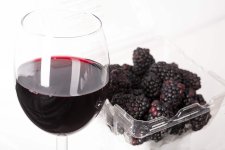Kenz
Culinary Explorer
give your dinner a twist with this


Ingredients:
- Blackberries: 3-4 pounds (fresh or frozen)
- Sugar: 2-3 pounds (adjust to taste and desired sweetness)
- Water: 1 gallon (filtered or spring water is best)
- Wine yeast: 1 packet (choose a wine yeast suitable for fruit wines)
- Yeast nutrient: 1 teaspoon (helps yeast ferment efficiently)
- Campden tablets: 2 tablets (optional, for sterilization)
- Pectic enzyme: 1 teaspoon (optional, helps with clarity)
Equipment Needed:
- Large fermentation bucket or food-grade plastic container with lid
- Fine mesh straining bag or cheesecloth
- Airlock and bung (to fit your fermentation vessel)
- Hydrometer (optional, for measuring alcohol content)
- Wine bottles for bottling
Instructions:
- Prepare the blackberries:
- If using fresh blackberries, rinse them thoroughly and remove any stems.
- If using frozen blackberries, thaw them completely.
- Sanitize equipment:
- Ensure all equipment that will come in contact with the wine (fermentation bucket, straining bag, airlock, etc.) is thoroughly cleaned and sanitized. You can use Campden tablets dissolved in water to sanitize.
- Extract juice from blackberries:
- Place the blackberries in a large pot and crush them to release their juices. You can use a potato masher or your hands (make sure they are clean).
- Heat the crushed blackberries over low heat for about 10 minutes to help release more juice and flavors.
- Strain the juice:
- Pour the heated blackberries and juice into a fine mesh straining bag or cheesecloth set over a clean fermentation bucket.
- Tie the bag securely and let it hang over the bucket to allow the juice to drip out. You can gently press the bag to extract more juice, but avoid squeezing it too hard to prevent bitterness.
- Add sugar and water:
- Stir in the sugar until it completely dissolves in the blackberry juice.
- Add the gallon of water to the bucket and stir well to combine.
- Add yeast and nutrients:
- Follow the instructions on your yeast packet to activate it (if necessary).
- Sprinkle the yeast over the surface of the must (the mixture of blackberry juice, sugar, and water).
- Add the yeast nutrient and pectic enzyme (if using) according to package instructions. These help the yeast ferment the sugars and improve clarity.
- Fermentation:
- Cover the fermentation bucket with a lid or a clean cloth and secure it.
- Place the bucket in a cool, dark place where the temperature is relatively stable (around 65-75°F or 18-24°C) for primary fermentation.
- Attach an airlock to allow gases to escape without letting air in. Check the airlock periodically to ensure it remains filled with water.
- Rack the wine (optional):
- After about 1-2 weeks, when fermentation slows down and sediment (lees) starts to settle at the bottom, you can rack the wine into a clean container to separate it from the sediment. This helps clarify the wine.
- Bulk aging (optional):
- Transfer the wine into a clean container for bulk aging if desired. This can improve the flavor and smoothness of the wine over several months.
- Bottle the wine:
- Once fermentation is complete (no more bubbles in the airlock and the wine clears), it's time to bottle.
- Use sanitized wine bottles and a siphon to transfer the wine, leaving sediment behind.
- Cork or cap the bottles and store them in a cool, dark place for several months to allow the flavors to develop.
- Enjoy your blackberry wine:
- Blackberry wine typically improves with age, so try to resist opening bottles for at least 6 months to a year after bottling.
